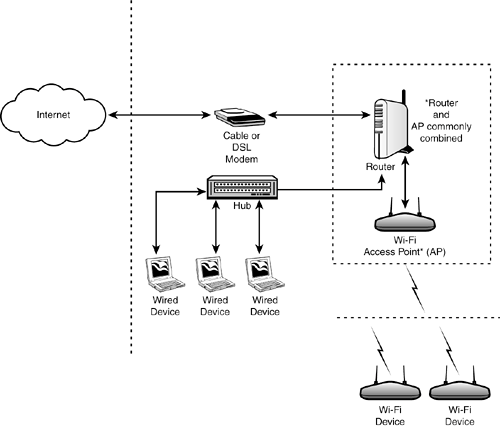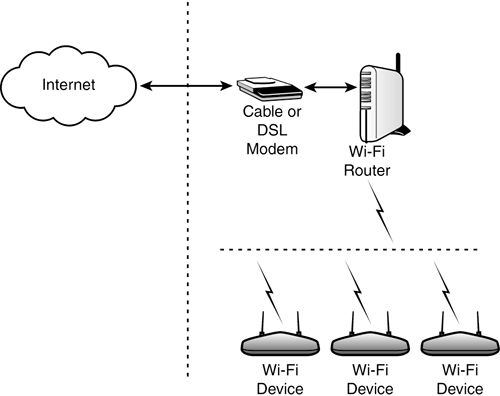Different Ways to Use Wi-Fi in a Network
| In the last section, I discussed some of the implications of "stringing together" computers to make something more powerful than any individual computer on the network. But suppose that you didn't have to physically "string" the computers? Well, of course, with Wi-Fi you don't. If you are going to Wi-Fienable a small network, there are really two ways to go about doing it:
Of course, the option of creating an entire network without wires using Wi-Fi is probably only available if you don't already have a network. If you already have a wired network that works, you most likely will not want to replace it. Instead, you'll just want to add Wi-Fi capabilities so that you can go mobile. For a completely Wi-Fi network, assuming that you want to have a shared connection to the Internet, you still need a cable or DSL modem for that purpose. In addition, you'll need a Wi-Fi router to connect to the modem. A Wi-Fi network of this sort will look something like the network shown in Figure 11.9. Figure 11.9. This network topology shows a setup that uses only Wi-Fiand no wiresto connect to the Internet.
Perhaps you already have a working wired network. It probably makes sense to keep it. After all, there's a great saying, "If it ain't broken, don't fix it." Besides which, it probably doesn't make sense to retrofit your network devices for Wi-Fi. You simply might not be able to retrofit some devices, such as older network printers, to work with Wi-Fi. You might not want to go out and buy all new equipment that works with Wi-Fi. Caution In some cases, household devices such as microwaves and telephones have spectrum conflicts with Wi-Fi networks. This can be another reason to maintain some wired connections in your network. If you are adding Wi-Fi capability to an existing wire-line network, what you have to do is connect a Wi-Fi access point (AP) "after" the router. ("After" means that you need to add the access point on your side of the router, not the Internet side.) Figure 11.10 shows what a small network with both wired and Wi-Fi capabilities might look like. Figure 11.10. In mixed wire-line and Wi-Fi networks, the Wi-Fi access point needs to be connected "after" the router. |
EAN: N/A
Pages: 204
